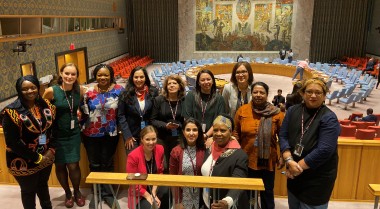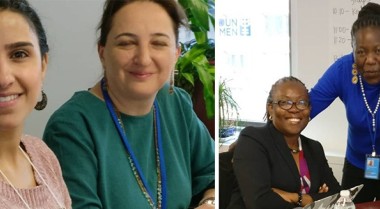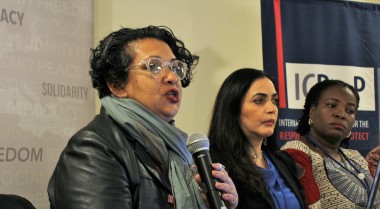
Women’s Perspective on Regional Peacebuilding
Women peacebuilders play a unique role by contributing to the articulation of a ‘people-centred – bottom-up’ perspective that is often missing in peacebuilding. This perspective includes transformative vision and expertise, grassroots knowledge and localised representation that play an important role in the analysis of conflict dynamics and enable effective early warning and response.
In Asia Pacific, women peacebuilders lead the initiatives to deepen a collective understanding of peacebuilding and conflict prevention by supporting multi-stakeholder exchanges and discussions that contribute to establishing a regional culture of nonviolence and prevention.
In South Caucasus, women peacebuilders have established the Network of Women Mediators to increase women’s involvement in multi-channel diplomacy processes, including high-level diplomacy. This will contribute to the universal recognition of the legitimacy and importance of the activities of women mediators.
In Cameroon, in efforts to prevent further divide between Anglophones and Francophones, women advance peace education in schools and empower wives of traditional leaders to promote sustainable preventive approaches within communities.
During the 2019 October Women, Peace and Security Week, GPPAC gender focal points shared their local realities and experiences in conflict prevention and worked to connect their local efforts to the international policy.
However, these efforts can only be successful if the international policy on Peacebuilding and Sustaining Peace translates into action at the national level.
What is the Role of Regional Peacebuilding?
Far too often, women peacebuilders noted, this is not happening. For one, it is because of the absence of a common vision on peacebuilding. But it is also because international efforts are improperly applied at the national level through a project-based “template” peacebuilding work that does not respond to the contexts on the ground and being brought from elsewhere.
Effective regional peacebuilding coordination has the capacity to overcome these obstacles: Coordinated regional efforts can develop resilient national capacities; bolster national commitment; and provide the timely identification of early warning signals and lead to effective prevention and peacebuilding. Because of their geographic proximity and deep understanding of the political dynamics in their regions, regional organizations are ideally placed to undertake (some of) these roles.
Coordinated regional efforts can develop resilient national capacities; bolster national commitment; and provide the timely identification of early warning signals and lead to effective prevention and peacebuilding.
One reason why sustaining peace is impossible without regional cooperation is because the majority of conflicts is cross-border. As the nature of armed conflicts has changed and new security threats emerge, regional organisations need to respond not only to the security concerns of their member states but also to those of the people living within these states. To resolve the situation in Nagorno-Karabakh, women encourage regional dialogue. “If dialogue stops and the current separation continues, it will build the ground for conflict to reemerge,” says Natalya Martirosyan from Armenia. “The only way in which we can ensure that the conversation is going is by ensuring that dialogue is happening among all peacebuilders in the region,” she adds.
The second reason to strengthen regional peacebuilding is the impact of regional joint analysis and sharing of experiences. Regional peacebuilding coordination would enable coherence and foster complementarity. When the UN, regional economic commissions (RECs), civil society, and external actors are running separate programs, clear root causes of violence can be missed. “While a lot of effort is being put into addressing crises, the levels of sexual and gender-based violence in Asia Pacific remains high and yet, none keeps seeing it as an issue in the region,” says Sharon Bghawan Rolls. “Regional inclusive multi-stakeholder platform for dialogue would bring these experiences and the existing efforts to address it into light to build sustainable peace in the region.”
The third reason is that in the current peacebuilding reality, largely dominated by political will, the only opportunities for women to mobilize support for their cause is at the regional level. “To address the situation in Cameroon, women have to go beyond the national level and work with regional peacebuilding actors to influence change,” says Justine Kumche. “When these opportunities are not there, the work stops.”
How can the 2020 Review of Peacebuilding Architecture Support action at the Regional Level?
As the 2015 Review of the UN Peacebuilding Architecture confirmed, the “nothing about us without us” principle makes those most affected and connected to local realities best placed to carry out conflict analysis and implement their activities, provides strategic and operational directions, and builds on existing capacities and structures. When peacebuilding solutions for conflict are directed from New York, peace will not be sustainable.
“To address the situation in Cameroon, women have to go beyond the national level and work with regional peacebuilding actors to influence change,” says Justine Kumche.
Women peacebuilders confirm that the current realities require better peacebuilding coordination at the regional level. This includes:
-
Creating regional platforms and facilitate regional dialogue and cooperation;
-
Coordinating joint analysis and peacebuilding strategies among stakeholders engaged in peacebuilding in each specific context;
-
Mapping and mobilizing actors best positioned to respond to identified peace and security challenges, and
-
Helping coordinate coherent and integrated peacebuilding efforts;
-
Support coordinated implementation of peace, development and humanitarian policies.
The ultimate purpose of sustaining peace as “a goal and a process” can only come to fruition with a strong leadership of regional peacebuilding actors due to the regional proximity, political space and connections not only with Member States but also the people within these states.


